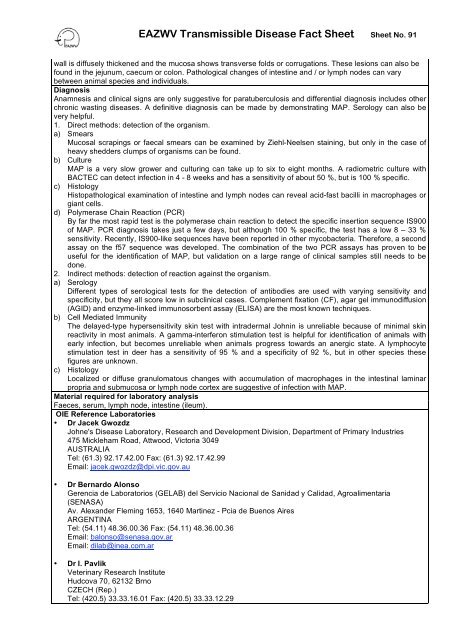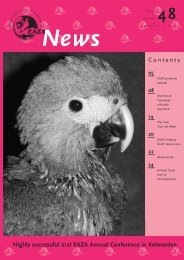EAZWV Transmissible Disease Fact Sheet
EAZWV Transmissible Disease Fact Sheet
EAZWV Transmissible Disease Fact Sheet
You also want an ePaper? Increase the reach of your titles
YUMPU automatically turns print PDFs into web optimized ePapers that Google loves.
<strong>EAZWV</strong> <strong>Transmissible</strong> <strong>Disease</strong> <strong>Fact</strong> <strong>Sheet</strong> <strong>Sheet</strong> No. 91<br />
wall is diffusely thickened and the mucosa shows transverse folds or corrugations. These lesions can also be<br />
found in the jejunum, caecum or colon. Pathological changes of intestine and / or lymph nodes can vary<br />
between animal species and individuals.<br />
Diagnosis<br />
Anamnesis and clinical signs are only suggestive for paratuberculosis and differential diagnosis includes other<br />
chronic wasting diseases. A definitive diagnosis can be made by demonstrating MAP. Serology can also be<br />
very helpful.<br />
1. Direct methods: detection of the organism.<br />
a) Smears<br />
Mucosal scrapings or faecal smears can be examined by Ziehl-Neelsen staining, but only in the case of<br />
heavy shedders clumps of organisms can be found.<br />
b) Culture<br />
MAP is a very slow grower and culturing can take up to six to eight months. A radiometric culture with<br />
BACTEC can detect infection in 4 - 8 weeks and has a sensitivity of about 50 %, but is 100 % specific.<br />
c) Histology<br />
Histopathological examination of intestine and lymph nodes can reveal acid-fast bacilli in macrophages or<br />
giant cells.<br />
d) Polymerase Chain Reaction (PCR)<br />
By far the most rapid test is the polymerase chain reaction to detect the specific insertion sequence IS900<br />
of MAP. PCR diagnosis takes just a few days, but although 100 % specific, the test has a low 8 – 33 %<br />
sensitivity. Recently, IS900-like sequences have been reported in other mycobacteria. Therefore, a second<br />
assay on the f57 sequence was developed. The combination of the two PCR assays has proven to be<br />
useful for the identification of MAP, but validation on a large range of clinical samples still needs to be<br />
done.<br />
2. Indirect methods: detection of reaction against the organism.<br />
a) Serology<br />
Different types of serological tests for the detection of antibodies are used with varying sensitivity and<br />
specificity, but they all score low in subclinical cases. Complement fixation (CF), agar gel immunodiffusion<br />
(AGID) and enzyme-linked immunosorbent assay (ELISA) are the most known techniques.<br />
b) Cell Mediated Immunity<br />
The delayed-type hypersensitivity skin test with intradermal Johnin is unreliable because of minimal skin<br />
reactivity in most animals. A gamma-interferon stimulation test is helpful for identification of animals with<br />
early infection, but becomes unreliable when animals progress towards an anergic state. A lymphocyte<br />
stimulation test in deer has a sensitivity of 95 % and a specificity of 92 %, but in other species these<br />
figures are unknown.<br />
c) Histology<br />
Localized or diffuse granulomatous changes with accumulation of macrophages in the intestinal laminar<br />
propria and submucosa or lymph node cortex are suggestive of infection with MAP.<br />
Material required for laboratory analysis<br />
Faeces, serum, lymph node, intestine (ileum).<br />
OIE Reference Laboratories<br />
• Dr Jacek Gwozdz<br />
Johne's <strong>Disease</strong> Laboratory, Research and Development Division, Department of Primary Industries<br />
475 Mickleham Road, Attwood, Victoria 3049<br />
AUSTRALIA<br />
Tel: (61.3) 92.17.42.00 Fax: (61.3) 92.17.42.99<br />
Email: jacek.gwozdz@dpi.vic.gov.au<br />
• Dr Bernardo Alonso<br />
Gerencia de Laboratorios (GELAB) del Servicio Nacional de Sanidad y Calidad, Agroalimentaria<br />
(SENASA)<br />
Av. Alexander Fleming 1653, 1640 Martinez - Pcia de Buenos Aires<br />
ARGENTINA<br />
Tel: (54.11) 48.36.00.36 Fax: (54.11) 48.36.00.36<br />
Email: balonso@senasa.gov.ar<br />
Email: dilab@inea.com.ar<br />
• Dr I. Pavlik<br />
Veterinary Research Institute<br />
Hudcova 70, 62132 Brno<br />
CZECH (Rep.)<br />
Tel: (420.5) 33.33.16.01 Fax: (420.5) 33.33.12.29
















